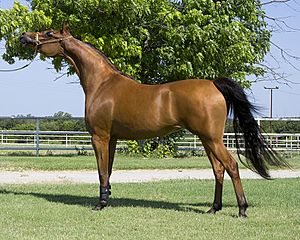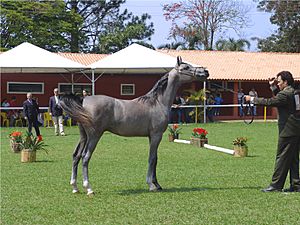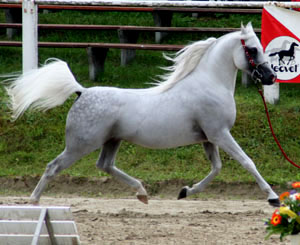Arabian horse facts for kids

An Arabian Mare
|
|
| Distinguishing features | finely chiseled bone structure, concave profile, arched neck, comparatively level croup, high-carried tail. |
|---|---|
| Alternative names | Arabian, Arab |
| Country of origin | Developed in the Middle East, most notably Arabian peninsula |
| Breed standards | |
| Arabian Horse Association (USA) | Breed standards |
| The Arabian Horse Society of Australia | Breed standards |
| The Arab Horse Society (UK) | Breed standards |
| World Arabian Horse Organization | Breed standards |
| Horse (Equus ferus caballus) | |
The Arabian horse is a special breed known for its beauty and amazing stamina. It's one of the oldest horse breeds in the world. Arabian horses are often bred with other horses to make them faster, more beautiful, and stronger. Today, you can find Arabian ancestors in almost every type of riding horse.
Arabian horses first developed in the deserts of Arabia. The Bedouin people raised them. Sometimes, families even brought their horses inside their tents for shelter and safety. This close bond with humans made Arabians very kind and quick to learn. They were also used as war horses, so they needed to be fast and alert. Because of these traits, it's important to treat Arabian horses with kindness and respect.
Contents
What Makes Arabian Horses Special?
Arabian horses have unique features that make them easy to spot. They have refined, wedge-shaped heads with a wide forehead and large eyes. Their nostrils are big, and their muzzles are small. Many have a special "dished" or concave (curved inward) profile.
Some Arabians also have a small bulge on their forehead between their eyes. The Bedouin people called this the jibbah. It's thought to help them breathe better in the dry desert air. Another special feature is their arched neck and a clean throatlatch (the area under the jaw). This allows them to be flexible when wearing a bridle.
Other unique traits include a long, level croup (the top of their hindquarters) and a tail that they carry naturally high. Well-bred Arabians have strong bones and good equine conformation (how their body is put together). They have deep hips and well-sloped shoulders.
Arabians are known for their incredible endurance. They are very strong and sound horses, meaning they are healthy and don't get hurt easily. In long-distance races, like Endurance riding, Arabians are often the top performers.
How Big Are Arabian Horses?
Arabian horses usually stand between 14.1 and 15.1 hands tall. (One hand is about 4 inches or 10 cm). Even though some are smaller than 14.2 hands, they are still called "horses," not "ponies."
Some people think Arabians aren't strong because they are smaller. But Arabians have very dense, strong bones. They also have short cannons (lower leg bones) and strong feet. This makes them very powerful for their size. Even a smaller Arabian can carry a heavy rider. They are strong and hardy light horses, good for many horse riding activities.
What is Their Temperament Like?
For hundreds of years, Arabian horses lived very closely with people in the desert. To keep them safe, valuable war mares were sometimes kept inside their owner's tent. This meant they were around children and family life every day. Only horses with a good nature were allowed to have babies. This is why Arabians today have such a good temperament.
For example, in the United States, Arabian stallions are one of the few breeds that children under 18 are allowed to show in almost all competitions.
Arabians are also known as "hot-blooded" horses. This means they are spirited and intelligent, like other fast breeds such as the Thoroughbred. Their intelligence helps them learn quickly and communicate well with their riders. However, they can also learn bad habits fast if not trained properly. They don't do well with harsh or unfair training.
Most Arabians naturally want to work with humans. If they are treated badly, they can become nervous, but they rarely become mean unless they are seriously mistreated.
What Colors Are Arabian Horses?
Arabian horses can be bay, gray, chestnut, black, and roan. Bay, gray, and chestnut are the most common colors. Black is less common.
All Arabians have black skin, except under white markings. This black skin helped protect them from the strong desert sun.
Gray and White Colors
Many Arabians look "white," but they are usually gray horses. The gray gene makes their hair turn white as they get older. A special type of gray is called "bloody-shoulder." This is a "flea-bitten" gray with dark spots on the shoulder.
Very few Arabians are truly "white" from birth. These horses have white hair, pink skin, and dark eyes. This is due to a rare genetic change.
Sabino Markings
One special white spotting pattern found in Arabians is called sabino. Sabino horses have white markings that go high up their legs, irregular spots on their belly and face, and white markings that go past their eyes or under their chin. Sometimes, these markings have lacy or roaned (mixed white and colored hair) edges.
Scientists are still studying exactly how sabino coloring is passed down in Arabians.
What Are Arabian Horses Used For?
Arabians are very versatile horses. They compete in many events like horse racing, horse shows, Endurance riding, and show jumping. They also make great pleasure horses for trail riding or working on a ranch.
You might also see Arabians in movies, parades, circuses, and other performances.
History of the Arabian Horse
There are many legends and myths about Arabian horses. One famous legend says the prophet Muhammad chose his five best mares, called Al Khamsa ("the five"), to start the Arabian breed. Another story says the Queen of Sheba gave an Arabian mare to King Solomon. Some even say Allah created the Arabian horse from the south wind, saying, "I create thee, Oh Arabian...I give thee flight without wings."
In real history, Arabians are one of the oldest horse breeds developed by humans. Pictures of horses that looked like modern Arabians were found on rocks in the Arabian Peninsula from as far back as 2,500 B.C. The ancestors of the Bedouin likely tamed horses soon after they tamed camels.
A horse skeleton found in the Sinai from 1700 B.C. is the earliest proof of horses in Ancient Egypt. This horse had a wedge-shaped head, large eyes, and a small muzzle, just like today's Arabian horse.
In the desert, humans were the only source of food and water for Arabian horses. When there was no grass, the Bedouin fed their horses dates (a fruit from palm trees) and camel's milk. Arabians had to survive on very little food and live in a harsh climate that was very hot during the day and very cold at night. Only the strongest horses survived. This made the Arabian horse very tough and able to live in a difficult world.
Famous Arabian Horses
Many famous people and fictional characters have been linked to Arabian horses. Napoleon rode a gray Arabian stallion named Marengo. George Washington rode a half-Arabian named Blueskin during the American Revolution. The fictional horse "The Black Stallion" from the books by Walter Farley was played by a real Arabian stallion named Cass Ole in the movie.
Images for kids
-
An Arabian horse in the desert. Painting by Antoine-Jean Gros, around 1810.
-
Battle of La Higueruela, 1431. Spanish fighting the Moorish forces of Nasrid Sultan Muhammed IX of Granada. Notice the high tail carriage of the Arabian horses.
-
Several noble families of Poland became major breeders of Arabian horses. Eustachy Erazm Sanguszko, painted by Juliusz Kossak.
-
Exhibitor from Syria holding an Arabian horse at the Hamidie Society exhibition, World's Columbian Exposition, 1893.
-
The Darley Arabian, a famous father of the Thoroughbred breed.
See also
 In Spanish: Caballo árabe para niños
In Spanish: Caballo árabe para niños


















